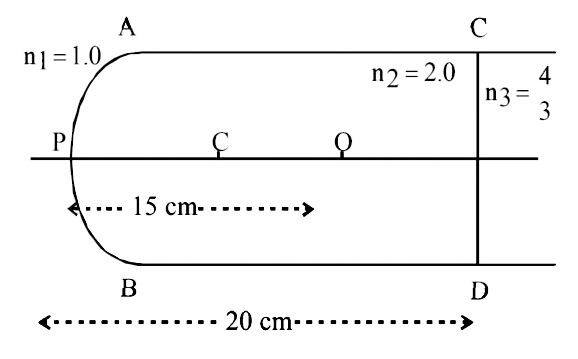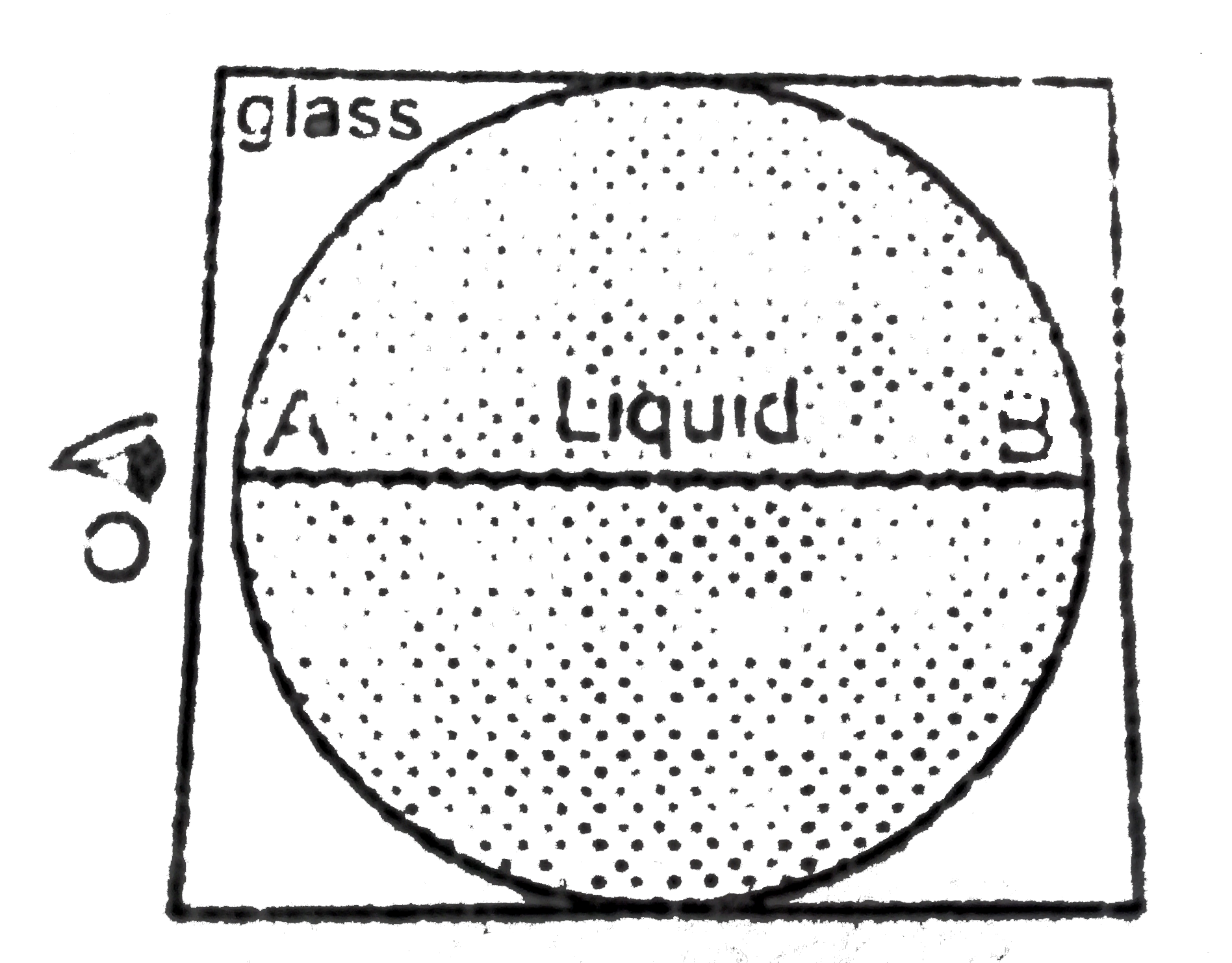Complete Solutions to DPP 1.3 of chapter RAY OPTICS of Class 12 book with complete answers and questions
| Class 12 | PHYSICS |
| Chapter | RAY OPTICS |
| CENGAGE PHYSICS DPP | DPP 1.3 |
| Number Of Questions | 15 |
| Academic Year | 2023-24 |
A parallel paraxial beam of light is incident on the arrangement as shown `(mu_(A)=3//2, mu_(B)=4//3)`. The two spherical surfaces are very close and each has a radius of curvature 10 cm. Find the point where the rays are focussed. (w.r.t. point of entry)

View SolutionA ray of light falls on the surface of a spherical glass paper weight making an angle `alpha` with the normal and is refracted in the medium at an angle `beta`. The angle of deviation of the emergent ray from the direction of the incident ray is :
View SolutionA poinit object `O` is placed in front of a glass rod having spherical end of radius of curvature `30cm`. The image would be formed at

View SolutionA glass hemisphere of radius 0.04 m and refractive index of the material 1.6 is placed centrally over cross mark on a paper (i) with the flat face, (ii) with the curved face in contact with the paper. In each case, the cross mark is viewed directly from above. The position of the images will be
View SolutionAn air bubble in sphere having 4 cm diameter appears 1 cm from surface nearest to eye when looked along diameter If `._(a)mu_(8)=1.5`, the distance of bubble from refracting surface is
View Solution
A slab of a material of refractive index 2 shown in fig. has a curved surface APB of radius of curvature 10 cm and a plane surface CD. On the left of APB is air and on the right CD is water with refractive indices as given in the figure. An object O is placed at a distance of 15 cm from the pole P as shown. The distance of the final image of O from P, as viewed from the left is......
View SolutionA parallel beam of light emerges from the opposite surface of the sphere when a point source of light lies at the surface of the sphere. The refractive index of the sphere is
View SolutionIn a thin spherical fish bowl of radius 10 cm filled with water of refractive index `4//3` there is a small fish at a distance of 4 cm from the centre C as shown in the figure. Where will the image of fish appears, if seen from E.

View SolutionThe observer 'O' sees the distance `AB` as infinitely large. If refractive index of liquid is `mu_(1)` and that of glass is `mu_(2)`, then `(mu_(1))/(mu_(2))` is :
 .
.
View SolutionThe first factor length `f_(1)` for refraction at a spherical surface is defined as the value of u corresponding to `v=oo` (as shown) with refractive indices of two mediums, as `n_(1)` and `n_(2)`. The second focal length `f_(2)` is defined as value of v for `u=oo`.

View SolutionFigure shows a point object placed in front of a transparent sphere of radius 20 cm and refractive index 1.5. The sphere forms an image due to refraction at surface I followed by refraction at surface II. The sphere is kept in air and the object is located at distance x from `P_(1)`. It is found that for `x gt x_(1)`, the image formed due to refraction at surface I is real, the final image formed by the sphere is also real and forms to the right of `P_(2)`. For `x_(2) lt x lt x_(1)`, the image formed by surface I is virtual while the final image formed by the sphere is real and forms to the right of `P_(2)`. However for `x lt x_(2)`, the image formed by surface I and also the final image formed by the sphere are virtual. It is also found that the final image is virtual if the distance of image formed by surface I from `P_(2)` is less than y. The object is now moved away from the sphere so that x becomes large and say, `x to oo`. In the given sphere is replaced by another one of the same radius but of refractive index 2.5, the final image is formed at distance `y_(2)` from `P_(2)`.
Distance `x_(1)` such that for `x gt x_(1)`, the image formed by surface I and also the final image are real, is

View SolutionFigure shows a point object placed in front of a transparent sphere of radius 20 cm and refractive index 1.5. The sphere forms an image due to refraction at surface I followed by refraction at surface II. The sphere is kept in air and the object is located at distance x from `P_(1)`. It is found that for `x gt x_(1)`, the image formed due to refraction at surface I is real, the final image formed by the sphere is also real and forms to the right of `P_(2)`. For `x_(2) lt x lt x_(1)`, the image formed by surface I is virtual while the final image formed by the sphere is real and forms to the right of `P_(2)`. However for `x lt x_(2)`, the image formed by surface I and also the final image formed by the sphere are virtual. It is also found that the final image is virtual if the distance of image formed by surface I from `P_(2)` is less than y. The object is now moved away from the sphere so that x becomes large and say, `x to oo`. In the given sphere is replaced by another one of the same radius but of refractive index 2.5, the final image is formed at distance `y_(2)` from `P_(2)`.
Distance `x_(2)` such that for `x_(2) lt x lt_(1)`, the image formed by surface I is virtual but the final image is virtual. Then, y will be
View SolutionFigure shows a point object placed in front of a transparent sphere of radius 20 cm and refractive index 1.5. The sphere forms an image due to refraction at surface I followed by refraction at surface II. The sphere is kept in air and the object is located at distance x from `P_(1)`. It is found that for `x gt x_(1)`, the image formed due to refraction at surface I is real, the final image formed by the sphere is also real and forms to the right of `P_(2)`. For `x_(2) lt x lt x_(1)`, the image formed by surface I is virtual while the final image formed by the sphere is real and forms to the right of `P_(2)`. However for `x lt x_(2)`, the image formed by surface I and also the final image formed by the sphere are virtual. It is also found that the final image is virtual if the distance of image formed by surface I from `P_(2)` is less than y. The object is now moved away from the sphere so that x becomes large and say, `x to oo`. In the given sphere is replaced by another one of the same radius but of refractive index 2.5, the final image is formed at distance `y_(2)` from `P_(2)`.
As stated above, if the distance of image formed by Surface 1 from `P_(2)` is less than y, the final image is virtual. Then, y will be

View SolutionFigure shows a point object placed in front of a transparent sphere of radius 20 cm and refractive index 1.5. The sphere forms an image due to refraction at surface I followed by refraction at surface II. The sphere is kept in air and the object is located at distance x from `P_(1)`. It is found that for `x gt x_(1)`, the image formed due to refraction at surface I is real, the final image formed by the sphere is also real and forms to the right of `P_(2)`. For `x_(2) lt x lt x_(1)`, the image formed by surface I is virtual while the final image formed by the sphere is real and forms to the right of `P_(2)`. However for `x lt x_(2)`, the image formed by surface I and also the final image formed by the sphere are virtual. It is also found that the final image is virtual if the distance of image formed by surface I from `P_(2)` is less than y. The object is now moved away from the sphere so that x becomes large and say, `x to oo`. In the given sphere is replaced by another one of the same radius but of refractive index 2.5, the final image is formed at distance `y_(2)` from `P_(2)`.
For the object placed at `x to oo`, the given sphere of refractive index 1.5 forms an image at distance `y_(1)` from `P_(2)`.

View SolutionFigure shows a point object placed in front of a transparent sphere of radius 20 cm and refractive index 1.5. The sphere forms an image due to refraction at surface I followed by refraction at surface II. The sphere is kept in air and the object is located at distance x from `P_(1)`. It is found that for `x gt x_(1)`, the image formed due to refraction at surface I is real, the final image formed by the sphere is also real and forms to the right of `P_(2)`. For `x_(2) lt x lt x_(1)`, the image formed by surface I is virtual while the final image formed by the sphere is real and forms to the right of `P_(2)`. However for `x lt x_(2)`, the image formed by surface I and also the final image formed by the sphere are virtual. It is also found that the final image is virtual if the distance of image formed by surface I from `P_(2)` is less than y. The object is now moved away from the sphere so that x becomes large and say, `x to oo`. In the given sphere is replaced by another one of the same radius but of refractive index 2.5, the final image is formed at distance `y_(2)` from `P_(2)`.
For the object placed at `x to oo`, a sphere of the same radius but of refractive index 2.5 forms an image at distance `y_(2)` from `P_(2)`

View Solution
DPP 1.3 questions and complete solutions for chapter RAY OPTICS of CENGAGE PHYSICS (HINGLISH) of Class 12